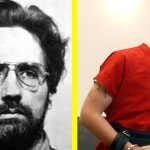From “The Bedroom Strangler” to “The Mad Bomber”, you are about to witness some of Canada’s most dangerous serial killers as we dive inside their terrifying crimes and look at where they are today.
10 – Gilbert Paul Jordan

Former barber Jordan is thought to have begun his serial killing rampage in 1965 and would find women in bars, buy them drinks, pay them for sex and encourage them to drink with him.
When the women had passed out from a night of drinking, Gilbert would then drown them using the same alcohol they had been drinking.
Police recorded the deaths as alcohol poisoning which made Jordan a very difficult killer to catch and it is thought he may have drunk with over 200 women per year, with many surviving the attacks.
On October 12, 1987, police began surveillance on Jordan after Vanessa Lee Buckner was found on the floor of the Niagara Hotel after a night of drinking with him.
On four different occasions, during the investigation, police would rescue four different women from Jordan’s attempted murders which involved money for dares to finish drinks quickly.
After the serial killers was arrested, Gilbert Jordan was arrested, charged, found guilty and sentenced to 15-years, reduced to nine years on appeal.
After release, he was re-arrested in 2002, for breach of probation and because he was found drinking in the presence of a woman.
After a further 15 months in jail, he was again released with strict conditions and a warning to women not to approach him.
He was acquitted of further charges in 2004 having been identified as being a party to binge drinking session in Winnipeg but died in 2006.
9 – Peter Woodcock

Diagnosed psychopath, serial killer and adopted child whom lived in numerous foster homes as an infant, his original name was changed to David Michael Krueger while behind bars.
Bullied by his peers, he would travel to parts of Totonto by foot, bicycle or train and attack children of various ages.
As the attacks became more violent, three children were eventually fatally wounded and Woodcock was locked up in a psychiatric facility.
Most of the treatments failed, and he would go on too murder a fellow psychiatric patient in 1991, eventually earning the nickname “The Serial Killer They Couldn’t Cure.”
He convinced inmates that he had contact with an imaginary gang called The Brotherhood and along with Ottawa killer, Bruce Hamill, he attacked Brockville inmate, Dennis Kerr.
Krueger died of natural causes while incarcerated at the Oak Ridge division of the Penetanguishene Mental Health Center on his 71st birthday.
8 – Cody Legebokoff

One of Canada’s youngest convicted serial killers, Legebokoff became well known for the Highway of Tears murders that occurred between 2009 and 2010 and makes him one of the worst serial killers.
His victims included 15-year old Loren Dawn Leslie who Legebokoff met online, Cynthia Frances Maas, Natasha Lynn Montgomery and Jill Stacey Stuchenko.
Legebokoff attacked his victims along the 719-kilometer road between Prince George and Prince Rupert in British Columbia with many of them working in the sex trade at the time of their deaths.
He was caught after being pulled over during a traffic stop while speeding, when police found the bloody implements in the back of his truck that had been used to carry out the crimes.
Legebokoff was convicted on four counts of first-degree murder on September 11, 2014 and sentenced to life in prison with no parole for 25 years.
The Judge who sentenced Legebokoff said that he should never be allowed to walk among society again and also added him to the Canadian sex offenders registry.
Legebokoff had an appeal turned down in 2016 and currently serves his sentence at the Warkworth Institution in Trent Hills, Ontario.
7 – Paul Bernardo

Nicknamed the Scarborough Rapist and the Schoolgirl Killer, Bernardo along with his former wife Karla Homolka, initially attacked over nineteen women between 1987 and 1990 making them one of the worst serial killers
He was interviewed by Toronto police detectives in July 1990, yet they failed to match him to the crimes and he was not charged.
After his job as an accountant he began smuggling cigarettes across the nearby Canada–United States border when he met Homolka.
His murderous ways commenced not long after and it was Homolka’s 1-year old sister Tammy, who became the first victim.
After Tammy’s death was ruled accidental, the couple moved on to their next unsuspecting victim, Leslie Mahaffy who was abducted while locked outside her house and she was killed after he blindfold fell off.
Finally, in 1992, Kirstin French, was kidnapped while walking home from school, however this time, multiple people saw the abduction take place.
Police formed the Green Ribbon Task Force to to investigate the murders of Mahaffy and French and twenty-six months after Bernardo had submitted a DNA sample, it came back as a match.
He was arrested on February 17th 1993 after Homolka had confessed the murders to her aunt and uncle while both of them were under 24-hour surveillance.
Bernardo was tried for the murders of French and Mahaffy in 1995 and Homolka gave evidence in exchange for a 12-year prison sentence.
Bernardo was convicted of a number of offences, including the two first-degree murders and two aggravated sexual assaults, and sentenced to life in prison without parole for at least twenty-five years.
He was designated as a dangerous offender and has moved through several prisons including Kingston Penitentiary, the Millhaven Institution and his latest residence, La Macaza Institution.
6 – Michael Wayne McGray

Growing up in a troubled environment McGray’s early life was marked by instability and violence, factors that likely contributed to his severe criminal behavior and makes him one of the worst serial killers.
McGray’s confirmed killing spree began in 1985 and he was diagnosed with severe personality disorders, including antisocial personality disorder and psychopathy.
McGray’s first known victim was 17-year-old hitchhiker, Elizabeth Gale Tucker, with his murderous spree later resulting in the deaths of oan Hicks and her 11-year-old daughter, Nina.
IN 1998, McGray attacked and killed Mark Gibbons, a truck driver whom he had a trivial dispute with and this murder led to his arrest.
McGray received multiple life sentences for his crimes, with no possibility of parole, yet, his confessions to additional murders have not all been verified and he remains a suspect in several unsolved cases.
Despite being considered highly dangerous, he was sometimes held in less secure facilities and this resulted in the murder of cellmate, Jeremy Phillips, at the Mountain Institution in British Columbia.
5 – Bruce McArthur

Targeting men, many of whom were associated with Toronto’s Gay Village, Bruce McArthur’s crime spree began on October 31, 2001 when he attacked model Mark Henderson in his apartment.
He then began a murder spree that shocked police with his modus operandi including McArthur luring his victims through dating apps and social networks.
Once he gained their trust, he would invite them to his home before attacking them and using his job as a landscaper to cover up the crimes.
The disappearances of men in Toronto’s Gay Village led to the formation of Project Houston in 2012 and later Project Prism in 2017, with one murder victim, Andrew Kinsman eventually leading police to McArthur.
McArthur was arrested on January 18, 2018, and, during a search of his apartment, police found evidence that included photos of his victims.
McArthur was charged with and pleaded guilty to eight counts of first-degree murder and in February 2019, he was sentenced to life imprisonment with no possibility of parole for 25 years, where he will be 91.
4 – Elizabeth Wettlaufer

Committing a series of crimes between 2007 and 2016, primarily targeting elderly patients in her care, former nurse Wettlaufer had anything but her patients best interests at heart.
Graduating from Conestoga College with a nursing degree in 1995, she began working in various healthcare facilities including Caressant Care, a long-term care home in Woodstock.
Her first murder occurred in 2007 when she injected James Silcox, an 84-year-old resident at Caressant Care Nursing Home in Woodstock, with a fatal dose of insulin.
Over the next nine years, she killed seven more elderly patients and attempted to kill six other patients through similar means.
In September 2016, Wettlaufer checked herself into a psychiatric hospital and confessed her crimes to staff, leading to her arrest on October 25th, 2016.
Wettlaufer was charged with eight counts of first-degree murder, four counts of attempted murder, and two counts of aggravated assault.
She waived her right to a preliminary hearing and pled guilty to all charges on June 1, 2017, later sentenced to life imprisonment without the possibility of parole for 25 years.
Currently held at an unspecified facility in Montreal, due to medical reasons, Wettlaufer will be eligible for parole in 2041.
3 – Clifford Olson

Olson had a long history of criminal activity, starting in his teenage years, including theft, burglary, and sexual assault.
His killing spree began in November 1980, where he targeted children and young adults, abducting and attacking them, with his known victims aged between nine and eighteen.
Arrested on August 12, 1981, on suspicion of attempting to abduct two girls, Olson was soon charged with the murder of Judy Kozma, whom he had attacked on July 9th, 1981.
After his murder charge, he confessed to a further 10 murders in exchange for C$10,000 for each victim to be paid into a trust for his wife, Joan, and then-infant son, Clifford III.
He was handed 11 concurrent life sentences to be served in Canada’s super-maximum security Special Handling Unit in Quebec.
One member of parliament in Canada even introduced a private member’s bill in the House of Commons calling for Olson’s execution.
He has, so far, made three attempts at parole, with every one being denied and the trial judge stating that he would never be released.
2 – Yves Trudeau

Known as “Apache” and “The Mad Bomber”, Trudeau was the Hells Angels leading assassin and a major participant in multiple biker conflicts throughout Canadian history and is one of its worst serial killers.
This Canadian outlaw biker, gangster and contract killer, was often frustrated by cocaine addiction and often had suspicion’s that his fellow gang members wanted him dead.
Standing five-foot-six, weighing 135 pounds and clean shaven with short hair, Trudeau did not look like the average Canadian prototypical biker, but he is considered to be the Hell’s Angels’ most prolific killer.
The Irish-Canadian West End Gang, who controlled the Port of Montreal and thus the importation of drugs into Quebec, frequently made use of Trudeau’s services to liquidate their rivals.
He attacked and killed Jean-Marc Deniger in May 1985 after the biker gang took his motorcycle and $46,000 in cash, only offering it back in return for two assassinations.
Knowing that the gang had taken out a $50,000 bounty on his head, Trudeau turned police informant and government witness.
He pleaded guilty to 43 counts of manslaughter in 1985, with 29 of his victims being killed from gunshot wounds and another ten from bombs.
He was sentenced to life in prison, with eligibility for parole in seven years, thanks to a controversial contract with the government.
Under his deal, the government also gave him $40,000 over the next four years and about $35 a week for cigarettes.
Trudeau was granted parole in 1994 and given a new identity and worked as an orderly in a nursing home and as a bus driver for the handicapped.
He returned to prison in 2004 after slipping back into his cocaine addiction and died from bone-marrow cancer in 2008.
1 – Robert Pickton

One of Canada’s most infamous serial killers, Robert Pickton worked on his family’s pig farm, which later became the site of his horrific crimes.
believed to have begun his killing spree in the early 1990’s, targeting vulnerable women from Vancouver’s Downtown East-side, many of his victims were sex workers or struggled with addiction.
Luring the victims to his farm with promises of money or drugs, he would then murder them, disposing of the remains around the property and he initially went un-noticed.
On February 6, 2002, police executed a search warrant for illegal firearms at Pickton’s farm and discovered personal items belonging to the missing women.
Further investigation and a subsequent search of the farm uncovered human remains and DNA evidence linking Pickton to numerous victims.
Pickton was charged with the first-degree murders of 26 women, though he later claimed to have killed 49 and his trial began on January 30, 2006.
On December 9, 2007, Pickton was convicted on six counts of second-degree murder, receiving a life sentence with no possibility of parole for 25 years, the maximum sentence under Canadian law.
The Pickton case led to a public inquiry, which resulted in the “Forsaken” report, outlining systemic issues and recommending improvements in police procedures and support for marginalized communities.
After a substantial forensic investigation, Pickton’s farm was eventually demolished and his crimes have been described among the most disturbing in Canadian history.
Thanks for reading this article on the top 10 most dangerous serial killers in Canada, don’t forget to subscribe for more crime content coming soon and check out this next crime video that we think you will enjoy.








